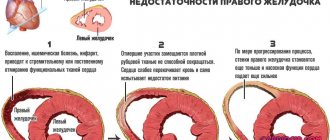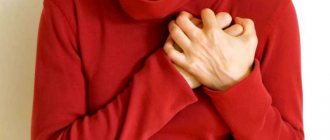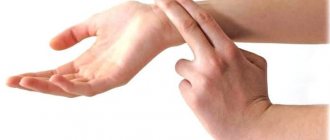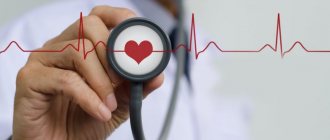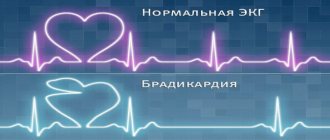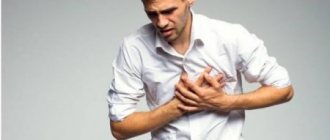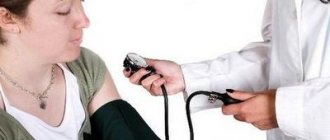During a myocardial infarction, the heart is affected by many factors, including oxygen deficiency, the influence of “stress hormones” - catecholamines, and changes in blood pressure. As a result, the patient's heart rate may change. Heart rhythm disturbances, which are accompanied by a significant change in pulse, are also dangerous.
Further in our material we will define:
- main and atypical forms of heart attack symptoms;
- what are the arrhythmias during a heart attack?
- What deviations do doctors pay special attention to?
- heart rate norms after heart surgery;
General information
A heart attack is a serious cardiac disease that poses a threat to the patient’s life. Most often it is provoked by thrombosis of the coronary artery. In such situations, the death of the patient can occur a couple of hours after the attack due to the complete cessation of blood circulation through the vessel.
Myocardial infarction is most often detected in inactive people. Emotional overload, poor nutrition, and difficult working conditions also play a significant role in the occurrence of an attack.
First of all, a heart attack is manifested by low blood pressure.
It decreases instantly, after the onset of sharp and acute chest pain. And not all people know what to do in such situations - such changes should prompt a person to immediately call an ambulance.
Pressure plays a significant role in the prognosis of the patient's further condition. The more rapid his fall, the greater the difficulty in resuscitating the patient. Making a diagnosis is complicated by the characteristics of each patient’s body. After all, some people have naturally low blood pressure, so it is very important to know its normal levels to determine further actions.
The patient experiences cardiogenic shock, which is manifested by the following symptoms:
- pale skin;
- attacks of nausea and vomiting;
- convulsions;
- cold sweat.
In addition, an acute heart attack can provoke the development of complications such as pulmonary edema, severe arrhythmia, psychosis and fear of death, left ventricular aneurysm, rupture of the heart muscle. In the latter case, sudden death occurs.
Alert symptoms and complications
Myocardial infarction in the first months of rehabilitation is accompanied by a pulse with a high frequency and low amplitude, which are caused by the presence of a defect in the muscle tissue of the heart. Heart rate monitoring is carried out to prevent complications.
The pulse rate characterizes the response of the cardiac conduction system to changes in the percentage of oxygen in the tissues. Pathological rapid heartbeat after a heart attack is accompanied by the following clinical symptoms:
- pain in the heart area;
- shortness of breath;
- cyanosis or hyperemia of the skin;
- peripheral edema;
- disturbance of consciousness.
Such conditions are caused by repeated ischemic attack, acute heart failure or other reasons.
Read also: Intensive care of myocardial infarction
Damage to a significant area of the myocardium is accompanied by expansion of the heart cavity and disturbances in the rhythm of contractions. An increase in the volume of organ chambers with hypokinesia is characterized by the development of thrombi (blood clots) in the area of reduced contractile function. Atrial fibrillation contributes to their separation from the walls of the heart and movement along the bloodstream. Stroke is one of the complications that occurs due to blockage of the brain arteries by a blood clot.
Changes in qualitative and quantitative pulse parameters in patients who have suffered a myocardial infarction are an important characteristic of the recovery process. Rhythm disturbances in such patients are corrected with medications in combination with lifestyle changes.
The responsible attitude of patients to health and regular monitoring of heartbeat characteristics help to rehabilitate and diagnose possible complications in the early stages.
The following sources of information were used to prepare the material.
Main symptoms of a heart attack
This disease can be recognized by the following signs:
- The presence of severe compressive pain localized in the chest. This attack cannot be stopped by Nitroglycerin. The pain syndrome may transfer to the left hand. The duration of the unpleasant sensations may subside within twenty minutes, but can last for several hours.
- An abnormal pulse during a heart attack is observed quite often (increased heart rate, rhythm disturbances).
- Nervous excitement, which causes shortness of breath.
Treatment after a heart attack
After a heart attack, the patient is treated with standard medications that protect and restore the heart muscle, prevent increased blood pressure and increased heart rate from the group of beta blockers.
With proper treatment, the normal pulse rate after myocardial infarction at rest is 50–65 per minute. This is exactly what your heart rate should be like when you take beta blockers all the time.
Drugs in this group, in the absence of contraindications, are prescribed as standard to all patients who have had a heart attack. While taking beta blockers, there is also a slow increase in heart rate during exercise, so you should not rely only on heart rate indicators when creating a training regimen.
What happens next
Due to low blood pressure and lack of blood circulation, anemia of the brain begins to develop. In this case, clouding of consciousness and fainting are possible. The ECG may show signs of tachycardia, systolic murmurs and other abnormalities.
Over time, the attacks intensify, and the pressure begins to rise. Pulmonary edema and cardiac asthma occur, and ventricular fibrillation may occur due to blockage of the venous artery.
When examining the patient, the specialist detects the following symptoms:
- Heart rate remains normal and is 60 beats per minute, but increased blood pressure is observed;
- when listening to the heart, the first sound is muffled;
- a blood test shows the development of a necrotic process in the myocardium;
- On the ECG, signs of pathology are revealed by inversion of the T-wave and the appearance of the Q segment.
In most cases, during a heart attack, a normal pulse remains, which, against the background of constantly increasing pressure, should raise suspicions among the doctor.
In addition to hardware, the disease is easily determined by external signs. For example, women experience asthma and shortness of breath even with minor physical exertion.
Due to lack of oxygen, coordination is impaired and vision problems appear. If this process is not stopped, myocardial necrosis subsequently develops, causing serious symptoms and complications.
What is submaximal frequency?
Cardiological patients during the rehabilitation period are recommended to perform non-intensive exercises (race walking, jogging), which are characterized by a predominant load on the heart, improving hemodynamic parameters and restoring body functions.
When selecting the intensity of exercises during the rehabilitation process, physical therapy specialists use interrelated indicators of submaximal heart rate and low aerobic power:
- low aerobic power determines the level of load at which less than 50% of oxygen is consumed (compared to the maximum);
- the submaximal pulse characteristic expresses the heart rate at which regulatory systems are strained within the limits of physiological norms, without compensating.
The value of the submaximal contraction frequency in patients depends on the length of time after a heart attack, the condition of the patients, age and gender (the myocardium of young men without pathologies increases strength and endurance at rates of 170 beats per minute; for a 60-year-old woman 3 months after a heart attack, this value is 90 -120 hits).
Heart rate is the number of heart contractions per unit of time (usually per minute). It is believed that heart rate is the same as pulse, but it is not.
As already mentioned, heart rate shows how many contractions the heart makes, namely its lower parts - the ventricles - per minute.
The pulse, or heart rate, is the number of times the artery dilates as the heart pumps blood per minute. Blood passing through the vessels during the contraction of the heart creates a bulge in the arteries, which is determined by touch.
The pulse value and heart rate can indeed be equal, but not always, but only in healthy people.
For example, with rhythm disturbances, the heart contracts erratically. If it contracts twice in a row, then the left ventricle does not have time to fill with blood. Thus, the second contraction occurs when the ventricle is empty and no blood is ejected from it into the aorta and peripheral vessels.
Therefore, the pulse in the arteries will not be heard while the heart is contracting. With atrial fibrillation and some other diseases, the heart rate does not correspond to the pulse rate. This phenomenon is called pulse deficit. In such cases, heart rate cannot be determined by measuring the pulse. This can only be done by listening to the heartbeat, for example using a phonendoscope.
Normal heart rate in adults ranges from 60 to 80 beats per minute. If the frequency is less than 60, it is bradycardia, if above 80, it is tachycardia.
Resting heart rate will vary depending on:
- person's age;
- his gender;
- body size;
- fitness.
In newborns, this figure is usually 120-140 beats per minute. If the child is premature, the value will be higher - from 140 to 160. In children by one year it decreases to 110-120, by five years - to 100, by 10 - to 90, by 13 - to 80.
In a trained person, the heart rate is lower than normal and averages about 50, while in those leading a sedentary lifestyle it can reach 100 beats at rest.
In women, the heart rate is approximately 6 beats higher than in men, and increases even more before the onset of menstruation.
When it changes
The value is not the same at different times of the day. The indicator changes throughout the day depending on the following factors:
- during physical activity;
- in moments of anger, fear, excitement and other emotions;
- depending on body position (lying, sitting, standing);
- after eating;
- after taking certain medications.
The heart rate increases after eating food, especially hot and protein foods.
When body temperature rises to 37 degrees, it increases by 20 beats.
During sleep it decreases by five to seven units.
Heart rate increases by about 10% when a person is sitting and by 20% when standing.
- when in a stuffy, hot room;
- during stress;
- during physical activity.
If your heart rate at rest is not normal, this may be a sign of illness. Usually, other manifestations of the disease are also present.
If tachycardia is accompanied by symptoms such as dizziness, shortness of breath, weakness, fainting, then the following cannot be ruled out:
- infectious disease;
- heart disease;
- onset of stroke;
- endocrine disorders;
- diseases of the nervous system;
- tumor processes;
- anemia.
Bradycardia can normally be observed in the following cases:
- for athletes (40 strokes);
- in people engaged in heavy physical labor;
- when taking certain medications.
It can also be a sign of illness:
- poisoning;
- heart attack;
- stomach ulcers;
- hypothyroidism;
- myocardial inflammation.
How to measure
Heart rate is measured at rest in a quiet and warm room. To carry out the procedure, you will need a stopwatch and an assistant. Approximately an hour before the measurement, you need to eliminate physical and emotional stress and smoking. It is not recommended to take medications or drink alcoholic beverages.
The person whose heart rate will be measured can lie down or sit down. After he takes the desired position, you need to lie down or sit quietly for five minutes.
The assistant places a clean, dry palm on the chest below the left nipple for a man and under the mammary gland for a woman.
It is necessary to determine the impact on the chest at the apex of the heart, which is called the apical impulse. It is heard in half of healthy people in the fifth intercostal space if the person is standing. If you can’t determine it, it means it falls on an edge.
After this, you need to take a stopwatch and start counting the person’s heartbeats for a minute. If the rhythm is incorrect, you need to do this for three minutes, then divide the resulting number by three.
When measuring your pulse, to get more accurate results, you need to do it on both sides of the body.
Maximum heart rate
This is the highest number of beats per minute that the heart can make. This indicator is used by athletes to know what maximum load the heart can be subjected to.
It is best to determine the maximum heart rate clinically, that is, this should be done by a cardiologist using a treadmill and an electrocardiograph.
There is another simplified way to find out the capabilities of your heart, but the result will be approximate. Maximum heart rate is determined by the formula:
- for men – 220 minus age;
- for women – 226 minus age.
Conclusion
Heart rate is an important indicator of heart function. Like heart rate, it is widely used in medicine for diagnostic purposes, as well as in sports to monitor the intensity of training.
The onset of an attack: changes in the patient’s body
If a heart attack has begun, then doctors must do everything to prevent myocardial systole from stopping. If during resuscitation measures it was not possible to restore the blood supply to the heart muscle, the patient’s condition deteriorates, which is why the following consequences are possible:
- the pressure drops so much that it can reach zero values;
- a sharp drop in body temperature;
- weak and chaotic pulse;
- internal organs and the brain are poorly supplied with blood, resulting in oxygen starvation and anemia;
- increased tachycardia causes acute heart failure;
- the most alarming symptom is the loss of consciousness of the patient, since in most cases this is fatal.
Difference between indicators for women and men
Pulse and blood pressure readings in both sexes may be identical, but this does not indicate the same course of the disease. According to statistics, men do more physical labor, which puts additional strain on the heart muscle and vascular system.
According to statistics, male heart attacks occur three times more often than female ones.
This is partly explained by the fact that the fair sex has hormonal protection against heart pathologies. During childbirth and pregnancy, their body experiences significant stress on the blood vessels, and therefore the body is initially programmed to resist such factors.
What is the pulse rate during a heart attack in both sexes? While men may have tachycardia and a significant increase in blood pressure during an attack, most women in this case maintain a normal pulse and the vascular system functions as usual. Therefore, to identify pathology in the latter, a thorough examination is necessary.
If a patient has had a heart attack, then the likelihood of a recurrence of the disease increases significantly. The reason for this is pressure drops as a result of malfunctioning of the heart muscle. Therefore, the patient should stay in the intensive care unit for some time, which will allow his body to be maintained in normal condition.
During daily monitoring, specialists monitor systole and diastole, which helps prevent the occurrence of a recurrent heart attack. Typically, the patient returns to the general ward after 10 days in intensive care.
If the female body normalizes blood pressure within five days after the attack, then in men drops are possible even after twice as long. The danger of a heart attack is that sometimes a relapse of the disease occurs even as a result of careful treatment. Therefore, after undergoing therapy, experts recommend that patients visit special sanatorium-type institutions. The absence of stress is also important, so the patient should, if possible, avoid serious nervous shocks.
Myocardial infarction: symptoms, forms and standards of treatment after surgery
During a myocardial infarction, the heart is affected by many factors, including oxygen deficiency, the influence of “stress hormones” - catecholamines, and changes in blood pressure. As a result, the patient's heart rate may change. Heart rhythm disturbances, which are accompanied by a significant change in pulse, are also dangerous.
Further in our material we will define:
- main and atypical forms of heart attack symptoms;
- what are the arrhythmias during a heart attack?
- What deviations do doctors pay special attention to?
- heart rate norms after heart surgery;
How to provide first aid for a heart attack
To prevent the development of serious complications, an immediate response to the first symptoms of the disease is necessary. If an attack occurs in a medical institution, the patient will be immediately hospitalized and emergency measures will be taken. But what to do if there are no medical personnel nearby? Providing first aid in such situations involves the following steps:
- You need to call an ambulance immediately. After this, the patient is provided with complete rest and sufficient fresh air. It is very important not to let the patient move, which in most cases turns out to be quite a difficult task - the patient is excited, and therefore it takes two or even three to restrain him.
- Give a Nitroglycerin tablet, which the patient should place under the tongue and dissolve. If this drug is not available, you can drink Validol. However, if there is a significant decrease in blood pressure, the use of these medications is prohibited.
- To calm the patient, you can use the following method: 30-40 drops of Corvalol are dropped onto a teaspoon of sugar. The patient must suck the resulting mixture.
- To reduce the formation of blood clots, the patient can be given an Aspirin tablet. It should be chewed and washed down with water. Taking two Analgin tablets will help relieve the pain.
- Mustard plasters, which are placed under the calves, can be used as a distraction.
You should not panic when you are sick, as stress significantly worsens the course of the disease. On the contrary, the atmosphere should be calm. If the patient has no pulse or breathing, then you need to urgently call an ambulance, notifying the doctors about cardiac arrest.
After this, it is necessary to perform an indirect massage of the organ. This is done as follows:
- The patient's body is placed in a horizontal position. His legs are raised 15 above the level of his body, which will ensure a rush of blood to the heart.
- We place our hands on the patient’s lower chest, palms down (two fingers above the solar plexus), and then apply strong pressure. Several such pressures should be performed. If such help arrives immediately after cardiac arrest, then the hope of starting it up increases significantly.
- After completing 15 pushes, it is necessary to proceed to artificial respiration. To do this, you need to close the victim’s nose and inhale air mouth to mouth, so that his chest rises.
These steps should be repeated until the patient has a pulse and breathing. Otherwise, they are performed until the ambulance arrives.
How to prevent another heart attack
Many patients are interested in what the pulse should be after a heart attack? With a favorable prognosis, the heart rate is completely normalized.
After the patient is discharged from the hospital, he should take careful care of his health. The main requirement is monitoring your pulse and blood pressure levels. If these indicators deviate significantly from the norm, you should immediately contact a specialist. In addition, you must follow these rules:
- To refuse from bad habits. This is a complete exclusion of drinking alcohol and smoking. Substances contained in alcohol and nicotine, even in small doses, can cause a recurrent attack.
- Nutrition correction. The diet should be balanced. The body requires a daily supply of all the minerals and vitamins necessary to strengthen the heart. You should eat as many fruits and vegetables as possible.
- Physical activity. This is especially true for those people who lead a sedentary lifestyle. You should consult a specialist regarding the necessary exercises.
- Periodic sanatorium treatment. Annual visits to such institutions have a beneficial effect on the patient’s condition. In addition to fresh air, procedures and a balanced diet, the necessary examination is also carried out here.
Some patients continue to have a high heart rate for some time after a heart attack. In such cases, it is necessary to be observed by a doctor until the indicators normalize.
Changes in pulse and blood pressure often warn of an approaching heart attack. In such cases, it is necessary to urgently call an ambulance, which will prevent an attack. If it has already taken place, then before the doctors arrive, first aid should be provided to the patient, and specialists should be informed about all rescue actions taken. The prognosis of the disease largely depends on literacy and speed during this difficult period.
Blood pressure during an attack
Blood pressure is determined by the force of the moving blood flow on the walls of blood vessels. These are two indicators characteristic of the moment of cardiac contraction and the intermediate phase of myocardial activity.
Normal blood pressure is considered to be 120/80, but other options are possible depending on the patient’s age and individual characteristics.
Any changes in blood pressure during a heart attack are unpredictable due to the complex clinical picture. As practice shows, pressure can increase to 190/100 or, conversely, decrease. An increase in pressure may be due to the effects of adrenaline, and a decrease in pressure is associated with hemodynamic disorders when the heart muscle is damaged.
Pulse rate
Myocardial infarction is not always accompanied by high blood pressure
Pulse is a universal indicator of the activity of the cardiovascular system, caused by the effect of blood flow on the walls of the arteries. The pulse value indicates the heart rate.
Read also: Hemorrhagic myocardial infarction
Normally, the heart rate depends on human activity, physical fitness and other factors. Thus, in a calm state, the frequency of myocardial contractions does not exceed 90 beats per minute, and during physical activity the figure can reach 120-150 beats per minute.
It is believed that during a heart attack, there is an inconsistent change in heart rate. Initially, tachycardia occurs, characterized by a sharp increase in heart rate (more than 120 beats per minute). Later, at the stage of hemodynamic disturbances, the pulse drops to low levels.
Pressure after myocardial infarction
A full course of treatment for a heart attack can take from several days to several months. In hospital settings, doctors carefully monitor the patient’s condition. The severity of complications of myocardial ischemia depends on the degree of damage to the muscular lining of the organ and the individual medical history of the patient.
Blood pressure gradually normalizes a few days after the attack occurs. As practice shows, low pressure can persist for 3-5 days. In the absence of severe complications, hypotension completely resolves after a week, but the specific indicators depend on the patient.

